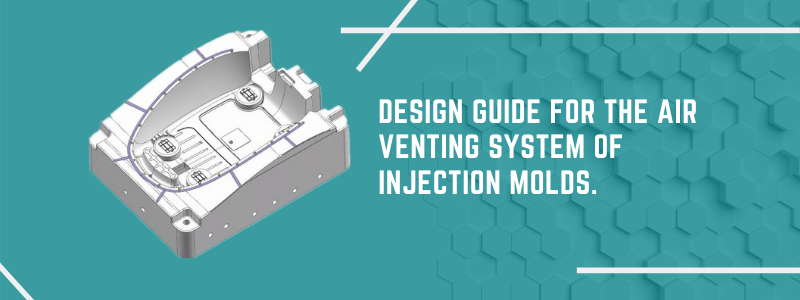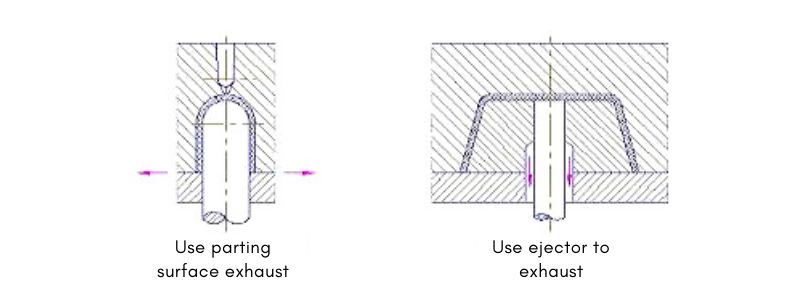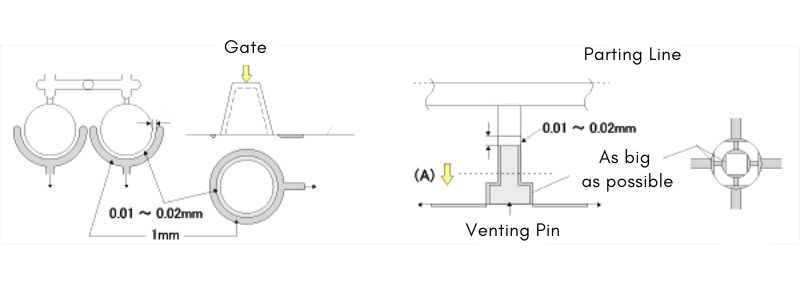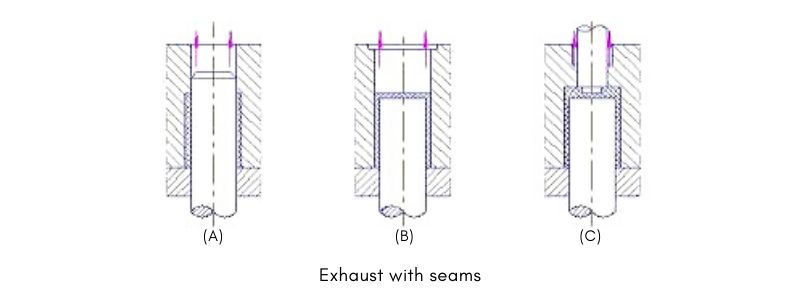
Whether the mold is set with an air venting has a great influence on the quality of plastic parts. For thin-wall plastic parts, small plastic parts or precision parts, the air venting is a crucial point. And in the same plastic part, the part away from the gate position needs to be designed with air venting. The air venting can not only avoid burns on the surface of the product and the insufficient injection volume, but also eliminate various defects of the product and reduce mold pollution.
The role of air venting.
The role of the air venting has two main points:
1. When the molten material is injected, the air in the mold cavity is venting;
2. Eliminate all kinds of gas generated during the heating process.
So, how to venting the cavity?
If the molten material is injected at the highest injection rate without leaving a focal spot on the product, it can be considered that the venting in the mold cavity is sufficient.
Air venting Type of injection mold.
For product molds with complex geometries, it is best to determine the air venting after several trial molds. The overall shortcoming of the overall structure in the mold structure design is poor venting.
(1) Exhaust from vent groove.
For molds that mold large and medium-sized plastic parts, the amount of gas to be removed is large. The vent groove is provided on the concave mold. The location of the vent groove is preferably at the end of the melt flow. It ensures smooth exhaust and no overflow. The width of the exhaust groove is about 3-5mm, the depth is less than 0.05mm, and the length is 0.7-1.0mm.
| plastic | Front-end dimensions of venting groove(mm) |
|---|---|
| ABS | 0.025-0.038 |
| POM | 0.013-0.025 |
| PMMA | 0.038-0.05 |
| PA | 0.008-0.013 |
| PC | 0.038-0.064 |
| PET/PBT | 0.013-0.018 |
| PE | 0.013-0.030 |
| PP | 0.013-0.030 |
| GPPS | 0.018-0.025 |
| HIPS | 0.020-0.030 |
| PVC | 0.013-0.018 |
| PU | 0.010-0.020 |
| SAN | 0.025-0.038 |
| TPE | 0.013-0.018 |
(2) Parting surface venting.
For small molds, the gap between the parting surfaces can be used for exhaust. But the parting surface must be at the end of the melt flow.

(3) the insert piece venting.
For the combined concave mold or cavity, the split gap can be used to exhaust.
(4) Clearance of ejector for venting.
Use the gap between the push rod and the template or core to exhaust, or intentionally add the gap between the push rod and the template.
(5) Use breathable steel.
Breathable steel is a material sintered with spherical particle alloy. The material is poor in strength but loose in texture, allowing gas to escape. A piece of this alloy can be placed where exhaust is required to meet exhaust requirements. But the diameter of the bottom vent hole should not be too large. In order to prevent the pressure and deformation of the cavity pressure.

(6)Venting trap.
On the outside of the confluence of plastic melts, a cavity is provided to allow gas to escape into it. A good exhaust effect can be obtained.
(7) Mandatory exhaust.
At the place where the gas is closed, an vent pin is provided. This method has good exhaust effect, but it will leave mark on the plastic parts. Therefore, the vent pin should be located in a hidden place of the plastic parts.
Set venting in the cavity.
There are many ways to exhaust the mold cavity, but each method must ensure:
1. The venting groove size should be designed to prevent materials from overflowing into the trap;
2. Prevent clogging of the venting groove.
Therefore, from the inner surface of the mold cavity to the outer edge of the mold cavity, the length of the venting groove of 6-12 mm or more, the groove height should be placed about 0.25-0.4 mm.
Too many air venting are harmful. It will cause unbalanced clamping pressure of the mold cavity parting surface. And it will cause cold flow or cracking of the cavity material, which is not allowed.
Venting is set at the end of the material flow of the gate system.
An venting groove is set at the end of the pouring flow of the gate system. Mainly refers to the venting groove at the end of the Branch of runner. Its width should be equal to the width of the shunt, and the height varies depending on the material.
Use the clearance around the ejector to venting.
Improper selection of the depth, width and position of the vent groove will cause flashing and burrs on the plastic parts. Affect the appearance and precision of products. The size of the ejector gap is limited to prevent flash around the ejector.
Venting method of other plastic parts.
Parts like gears don’t allow even the smallest flash. The gear parts are best exhausted in the following ways:
(1) Completely remove the gas in the runner;
(2) Shot peening the matching surface of the parting surface with silicon carbide abrasive with a particle size of 200.
Design method of the mold vent groove.
For the integral cavity and core, there are several venting methods:
1. Use the groove or insert installation part of the cavity;
2. Use the insert seams on side;
3. Partially made into a spiral shape;
4. Install the slotted slat core in the longitudinal position and set hole.
5.When air venting is extremely difficult, the mold can adopt a mosaic structure. The dead corners of some molds are not easy to open the exhaust groove. Without affecting the appearance and accuracy of the product, the mold is changed to a mosaic structure. This is conducive to processing the vent groove, and can also improve the processing difficulty and facilitate maintenance.

Venting groove design when thermosetting plastic is molded.
1. All shunts in front of the gate should be vented.
2. The width of the exhaust groove should be equal to the width of the shunt, and the height is 0.12mm. All sides of the cavity should be vented. The exhaust slots should be separated by 25mm, the width is 6.5mm, and the height is 0.075-0.16mm. It depends on the fluidity of the material. Softer materials should take lower values.
3. The ejector should be enlarged as much as possible. 3-4 planes with a height of 0.05mm should be ground on the cylindrical surface of the ejector rod. The direction of the wear scar should be along the length of the ejector. Grinding should be carried out with a fine-grained grinding wheel. The end face of the ejector rod should be ground with a chamfer of 0.12mm.
In conclusion
Appropriate set air venting can greatly reduce the injection pressure, injection time, pressure holding time and mold clamping pressure. Thereby improving the production efficiency of plastic parts and reducing production costs.
